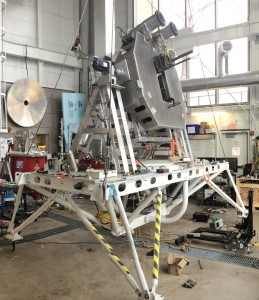The BLAST-TNG gondola will borrow from the BLAST gondola that flew five times since between 2006 and 2013, however a number of systems will undergo significant redesigns to accommodate the primary mirror and the receiver which have both increased in size significantly.
The gondola comprises two major mechanical systems. The first is an outer frame that allows the telescope to rotate in azimuth with respect to the balloon. This is achieved via a high moment of inertia reaction wheel located below the receiver, and a pivot motor that couples the flight train to four aircraft cables located at the corners of the frame. The outer frame also houses the flight control electronics, solar array batteries and charge controllers that power the receiver, and supports the inner frame on large ladder-like supports. The inner frame is a stiff structure that supports the mirror assembly, cryogenic receiver, and detector readout electronics. The inner frame is precisely pointed in elevation with respect to the outer frame with a direct drive motor, and is actively balanced about its rotation axis.
 A series of aluminized Mylar baffles and sunshields on both the inner and outer frame protect the telescope from thermal changes during flight and shield the sensitive optics from direct sun. These baffles will be optimized to allow BLAST-TNG to point to within 40 degrees in azimuth of the sun, over a range in elevation from 20 to 55 degrees.
A series of aluminized Mylar baffles and sunshields on both the inner and outer frame protect the telescope from thermal changes during flight and shield the sensitive optics from direct sun. These baffles will be optimized to allow BLAST-TNG to point to within 40 degrees in azimuth of the sun, over a range in elevation from 20 to 55 degrees.





